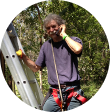-
Member Login
- Home
- About
- Institute Groups
- Membership
- Events
- News & Publications
- Institute Programs
- Resources
- Jobs Board
- Contact Us
- Site Info
Ross Goldingay
Ross Goldingay
Abstract | Facilitated movement of small mammals through a road-underpass by a wildlife railing
Wildlife underpasses in Australia are commonly fitted with timber railings to facilitate the passage of arboreal and scansorial mammals but there are no published accounts of railing use. We compared detections of such mammals on railings in two underpasses to detections on the ground in these and underpasses without railings along the Oxley Highway at Port Macquarie, New South Wales.
The brown antechinus (Antechinus stuartii) and the black rat (Rattus rattus) were detected on a closely monitored railing on 12-14% of nights over three years. These species were detected on the ground of underpasses on <1% of nights.
Koalas (Phascolarctos cinereus) and brushtail possums (Trichosurus spp.) were infrequently detected; koalas only on the ground and brushtail possums mostly on the ground.
These observations suggest road crossings by small scansorial mammals can be facilitated by timber railings. There is currently a huge information gap concerning wildlife use of railings in underpasses that must be addressed.
Bio | Ross Goldingay
 Ross is a wildlife ecologist based at Southern Cross University in northern NSW with >20 years’ experience in studying road ecology. He has studied the conservation requirements of a range of species in eastern Australia including green and golden bell frogs, broad-headed snakes, squirrel gliders, yellow-bellied gliders and koalas. He has advocated for the installation of tall wooden poles to assist gliding mammals to cross roads since the early 1990s. With collaborators such as Brendan Taylor, he has conducted many key studies documenting wildlife road kill, the use by wildlife of road underpasses, and the use of wooden poles by gliding mammals. Other key interests include using nest boxes to manage and study hollow-using species, and in how to mitigate the effects of urban development on wildlife.
Ross is a wildlife ecologist based at Southern Cross University in northern NSW with >20 years’ experience in studying road ecology. He has studied the conservation requirements of a range of species in eastern Australia including green and golden bell frogs, broad-headed snakes, squirrel gliders, yellow-bellied gliders and koalas. He has advocated for the installation of tall wooden poles to assist gliding mammals to cross roads since the early 1990s. With collaborators such as Brendan Taylor, he has conducted many key studies documenting wildlife road kill, the use by wildlife of road underpasses, and the use of wooden poles by gliding mammals. Other key interests include using nest boxes to manage and study hollow-using species, and in how to mitigate the effects of urban development on wildlife.
We acknowledge and value the rights and interests of Indigenous Peoples in the protection and management of environmental values through their involvement in decisions and processes, and the application of traditional Indigenous knowledge.

